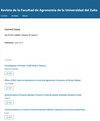Interaction between the incidence of Prodiplosis longifila Gagné (Diptera: Cecidomyiidae) and management practices in tomato crops in Manabí, Ecuador
IF 0.5
4区 农林科学
Q4 AGRONOMY
Revista De La Facultad De Agronomia De La Universidad Del Zulia
Pub Date : 2022-10-02
DOI:10.47280/revfacagron(luz).v39.n4.05
引用次数: 0
Abstract
The insect pest Prodiplosis longifila Gagné (Diptera: Cecidomyiidae), causes severe losses to the tomato crop in Ecuador, in the provinces of Manabí, Pichincha, Carchi, Cotopaxi, Azuay, and Chimborazo, where the main producing areas of this solanaceous crop in the country are located. The objective of this research was to study the interaction of the incidence of this pest with tomato crop management practices. The evaluations were carried out in twenty-five production units in different cantons of Manabí: in Bolívar (two), Portoviejo (eight), Rocafuerte (five), Santa Ana (one), Sucre (three) and Tosagua (six). Each unit had an area of 2500 m2, where 25 plants were randomly marked and the number of healthy, infested and damaged shoots was recorded, as well as the number of healthy and damaged fruits. In addition, a survey was applied to growers to determine the management practices carried out during the crop cycle. Descriptive analysis, significance tests, hierarchical clustering and chi-square tests were carried out. It was determined that in the cantons of Portoviejo, Tosagua and Rocafuerte, infestations did not exceed 13 % and a severity of up to 15 %, reaching 25 % of damaged fruit in Tosagua. The agronomic practices applied were trellising, drip and gravity irrigation, collection of infested fruit and chemical insecticides. There was an interaction with P. longifila between infested fruit collection and trellising, which influenced its infestation and severity, respectively. These incidences were significantly high at harvest, where highly toxic insecticide applications were substantially increased indiscriminately.厄瓜多尔Manabí地区番茄作物中长枝芽蛾(双翅目:蠓科)发病率与管理措施的相互作用
在厄瓜多尔的Manabí、Pichincha、Carchi、Cotopaxi、azway和Chimborazo等省(该国番茄作物的主要产区),害虫Prodiplosis longifila gagn(双翅目:cecidomiidae科)对番茄作物造成严重损失。本研究的目的是研究这种害虫的发生与番茄作物管理措施的相互作用。评估在Manabí不同州的25个生产单位进行:Bolívar(2个)、Portoviejo(8个)、Rocafuerte(5个)、Santa Ana(1个)、Sucre(3个)和Tosagua(6个)。每个单元的面积为2500平方米,随机标记25株植物,记录健康、侵染和受损芽的数量,以及健康和受损果实的数量。此外,还对种植者进行了一项调查,以确定在作物周期内实施的管理措施。进行描述性分析、显著性检验、分层聚类和卡方检验。经确定,在波托维耶霍、托萨瓜和罗卡富尔特三个州,侵染率不超过13%,严重程度高达15%,在托萨瓜,侵染率达25%。采用棚架、滴灌和重力灌溉、收集侵染果实和化学杀虫剂等农艺措施。侵染果实采集与棚架布置之间存在互作,分别影响了侵染程度和严重程度。在收获季节,这些发生率非常高,在收获季节,高毒性杀虫剂的使用大大增加。
本文章由计算机程序翻译,如有差异,请以英文原文为准。
求助全文
约1分钟内获得全文
求助全文
来源期刊
CiteScore
0.50
自引率
0.00%
发文量
45
审稿时长
>12 weeks
期刊介绍:
La Revista de la Facultad de Agronomía de la Universidad del Zulia publica artículos científicos, notas técnicas, comunicaciones rápidas y artículos invitados originales e inéditos, es decir, que no hayan sido publicados ni enviados simultáneamente a otra revista para su publicación, de autores interesados en el campo agrícola vegetal y agrícola animal. De presentarse el caso que el autor o autores hubiesen enviado o publicado su manuscrito simultáneamente en otra revista, podrán ser sancionados con la no publicación en esta revista por tiempo indefinido.
Se admiten manuscritos escritos en idioma Español, Portugués o Inglés, con un resumen en Español o Portugués y otro en Inglés (Abstract).

 求助内容:
求助内容: 应助结果提醒方式:
应助结果提醒方式:


